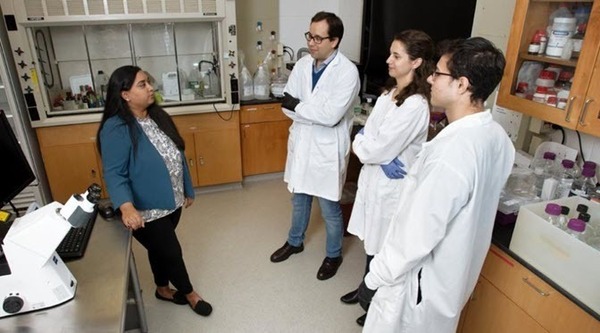
Meenal Datta, assistant professor of aerospace and mechanical engineering, was recently awarded a National Institutes of Health Career Transition Award through the National Cancer Institute for her work at the intersection of mechanical engineering and cancer immunology.
She is working to better understand glioblastoma, one of the most complex and deadly cancers. According to the National Brain Tumor Society, glioblastoma accounts for approximately 48 percent of all malignant brain tumors and kills more than 10,000 people every year. Even with treatment, the average length of survival after a diagnosis is between 12 to 18 months.
To improve these outcomes, Datta aims to understand and target the novel and biophysical interactions in the brain, specifically in the glioblastoma microenvironment.
“It’s important to think about the physics of tumors and cancer the same way we would for healthy tissues,” she said. “Tumors contain all the same components as organs, but they are corrupted in ways that help the cancer grow.
“I’m especially interested in how tissue mechanics play a role in disease progression and treatment response or resistance in difficult-to-treat cancers like glioblastoma.”
Datta says it is also important to consider the abnormal mechanical forces that tumors can exert, especially in the brain, where they can wreak havoc on normal brain tissue, even to the point of compressing the surrounding brain, reducing blood flow, and killing neurons outside of the tumor.
Datta helped create a compression device that mimics the mechanical forces at play in the brain. “Employing compression rather than implanting a tumor, we found the same effects just from the mechanics even when a tumor is not present,” she said.
“In other words, it’s not as simple as cancer cells damaging or killing the tissues around them. We now know that mechanical forces alone can exert these detrimental effects in the brain. Even benign tumors can exhibit these destructive mechanical forces.”
In addition, glioblastoma tumors are full of immune cells, Datta said. As much as half of a brain tumor can be made up of innate immune cells like macrophages.
“In the glioblastoma microenvironment, the immune cells are reprogrammed to help the cancer grow,” she said. “I believe these cells are contributing to the mechanical forces and encouraging a reciprocal feedback loop that makes the tumor resistant to therapy while promoting tumor growth.”
Datta joined the Notre Dame Engineering faculty in August 2021. She came to Notre Dame from her position as a postdoctoral research fellow at Harvard Medical School.

She and her team in the Tumor Immune Microenvironment and Mechanics (TIME) Lab will collaborate on this work with the Notre Dame Integrated Imaging Facility, Harper Cancer Research Institute, the Institute for Precision Health at Notre Dame, the Lucy Family Institute for Data and Society, and the Indiana Clinical and Translational Sciences Institute.
“Our goal is to better understand the mechanical and biological forces at work so we can re-engineer the glioblastoma microenvironment, potentially with already FDA-approved therapies for rapid clinical translation,” said Datta.
“If we can overcome some of these mechano-immunological pathologies, we may be able to enhance the outcomes of immunotherapy and other interventions more effectively to increase survival rates.”
— Nina Welding, College of Engineering
Originally published by at harpercancer.nd.edu on November 19, 2021.